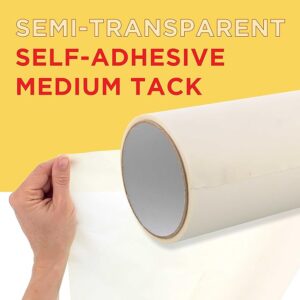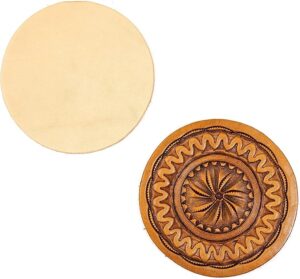Laser engraving on leather opens up a world of creative possibilities, allowing for intricate designs, personalized details, and unique textures. However, the success of any leather engraving project greatly depends on selecting the right type of leather.

In this comprehensive guide, we’ll explore the various factors to consider when choosing leather for laser engraving.
Table of Contents
Factors to Consider When Choosing Leather For Laser Engraving:
1. Type of Leather:
The type of leather significantly impacts the engraving outcome. Two common types are:
- Vegetable-Tanned Leather: Known for its natural appearance, it engraves well and develops a charming patina over time.
- Chrome-Tanned Leather: Softer and more pliable, it can be engraved, but the results may be subtler compared to vegetable-tanned leather. However, it’s a good idea to enquire with your leather supplier about the amount of hexavalent chromium (if any) in the leather patches that are chrome-tanned that they offer. However, keep in mind that any leather that has an appropriate exhaust system is safe to use with a laser.
2. Thickness:
Leather comes in various thicknesses, measured in ounces (oz). Consider:
- Thin Leather (2-4 oz): Suitable for detailed engravings, often used in projects like wallets.
- Medium to Thick Leather (5-8 oz): Ideal for items like belts, allowing for deeper and more substantial engravings.
3. Texture:
The texture of the leather affects the engraving’s final appearance:
- Smooth Leather: Offers a consistent surface for detailed engravings, perfect for intricate designs and text.
- Textured or Distressed Leather: Adds character but may result in a more rustic appearance after engraving.
4. Surface Finish:
Consider the finish applied to the leather:
- Aniline-Finished Leather: Known for a natural look and feel, it may engrave well, but the finish can impact engraving contrast.
- Pigmented Leather: Requires higher laser power due to its protective topcoat.
5. Color and Dye:
The color of the leather influences engraving visibility:
- Natural or Light-Colored Leather: Shows details prominently, providing a high-contrast look.
- Dark-Colored Leather: Engravings may be subtle, requiring careful design considerations and laser settings.
6. Quality of Leather:
Opt for high-quality, full-grain leather for better engraving results. Full-grain leather tends to engrave more consistently and beautifully than lower-quality or corrected-grain leather.
7. Testing and Experimentation:
Before starting a significant project, conduct test engravings on small leather scraps. This allows you to fine-tune laser settings and ensure optimal results on your chosen leather type.
8. Masking:
Laser engraving on leather is a delicate process that requires precision and attention to detail. One crucial step to ensure clean and professional results is masking the leather before engraving. Masking protects the surface from smoke, residue, and potential damage during the engraving process. Below we’ll explore how to effectively mask leather for laser engraving and recommend suitable masking tape for the job.
Materials Needed:
- Leather Piece: Choose the type and color of leather suitable for your engraving project.
- Masking Tape: Select a high-quality masking tape suitable for laser engraving.
Steps to Mask Leather for Laser Engraving:
- Step 1: Select the Right Masking Tape:
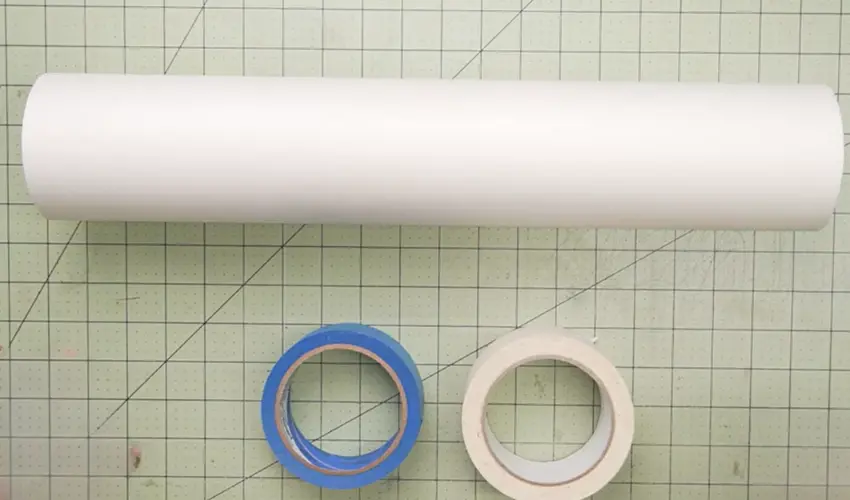
Choosing the correct masking tape is crucial. Opt for a low-residue and heat-resistant tape designed for laser engraving applications. Blue painter’s tape and certain specialty masking tapes don’t work well for this purpose. We have tested hundreds of masking tapes over the years and have found this semi-transparent masking tape available on Amazon (Paid Link) to be the best.
- Step 2: Cut the Masking Tape:
Cut the masking tape into strips or pieces that align with the dimensions of your leather piece. Ensure that the tape covers the entire engraving area and extends slightly beyond the edges.
- Step 3: Prepare the Leather Surface:
Clean the leather surface thoroughly to remove any dirt, dust, or oils. A clean surface ensures better adhesion of the masking tape.
- Step 4: Apply the Masking Tape:
Carefully apply the masking tape to the leather surface, smoothing it out to avoid air bubbles. Ensure that the entire engraving area is covered. Overlapping the edges slightly helps in creating a sealed barrier.
- Step 5: Press Down Firmly:
Press down firmly on the masking tape to ensure good adhesion to the leather. This step is crucial for preventing the laser from seeping underneath the tape during engraving.
- Step 6: Trim Excess Tape:
Using a craft knife or scissors, trim any excess tape extending beyond the edges of the leather. This creates clean edges for a professional finish.
- Step 7: Check for Secure Adhesion:
Double-check that the masking tape is securely adhered to the leather surface. Any loose edges or bubbles may compromise the engraving quality.
- Step 8: Proceed with Laser Engraving:
With the leather properly masked, proceed to set up your laser engraving machine. Ensure that the laser settings are suitable for the type of leather you’re working with.
- Step 9: Post-Engraving Care:
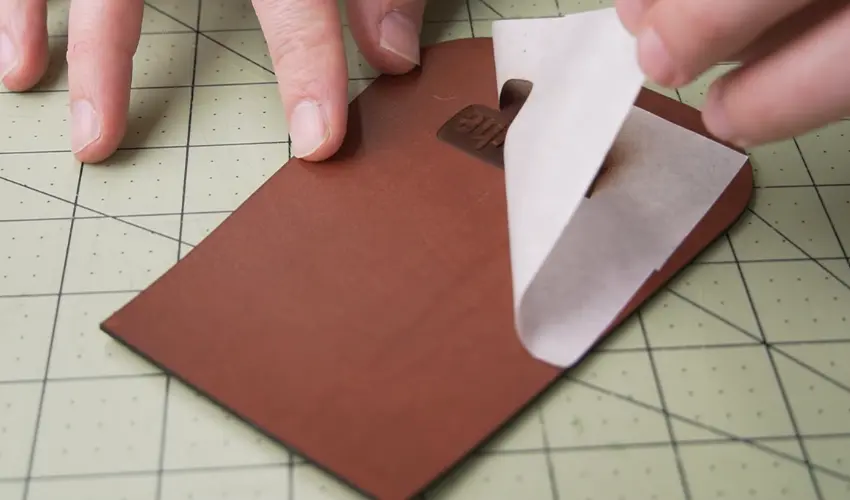
Once the engraving is complete, carefully remove the masking tape. Take your time to avoid any potential damage to the engraved area.
Tips for Successful Masking:
- Use Low-Residue Tape: Choose masking tape with minimal adhesive residue to simplify the post-engraving cleanup process.
- Avoid High-Adhesive Tapes: Steer clear of tapes with excessive adhesion, as they may damage the leather surface upon removal.
- Test on Scrap Pieces: Before masking your main project, conduct tests on small leather scraps to ensure compatibility with your chosen tape.
By following these steps and selecting the right masking tape, you can achieve clean and precise laser engravings on leather, enhancing the overall quality of your projects.
9. Cleanliness:
Ensure the leather surface is clean and free from oils or residues before engraving to achieve a crisp and detailed result.
10. Adjustable Laser Settings:
Laser engraving on leather is a versatile and intricate process that demands precise control over various settings to achieve optimal results. Adjusting laser settings for leather involves finding the right balance between power, speed, and resolution.
Because CO2 lasers can cut through leather with minimal edge burns in a single pass, it is advised to use one with a power rating of at least 40W when cutting leather. On the other hand, thin leather pieces can also be cut in several passes using a 10W diode laser.
Below we’ll delve into the essential laser settings to ensure a successful and high-quality laser engraving on leather.
Power Settings: Low to Medium Power:
- Reasoning: Leather is a relatively delicate material, and using too much power can lead to burning or scorching.
- Recommended Range: Start with low to medium power settings (20% to 40%) and adjust based on the type and thickness of the leather.
Speed Settings: Moderate to High Speed:
- Reasoning: Faster engraving speeds help prevent excessive heat buildup, reducing the risk of burning and ensuring cleaner lines.
- Recommended Range: Begin with moderate to high speeds (500 to 1000 mm/s) and refine based on the desired engraving depth and detail.
Resolution Settings: Higher DPI for Detail:
- Reasoning: Leather engraving often involves intricate designs and fine details. Higher dots per inch (DPI) settings enhance precision.
- Recommended Range: Use a resolution of 500 to 1000 DPI for intricate and detailed engravings.
Test Engravings: Always Conduct Test Runs:
- Reasoning: The characteristics of leather can vary, so it’s crucial to perform test engravings on scrap pieces before working on the final project.
- Procedure: Test different combinations of power, speed, and resolution settings to identify the optimal configuration.
Focus Adjustment: Ensure Proper Focusing:
- Reasoning: A well-focused laser beam contributes to sharper and clearer engravings.
- Procedure: Adjust the focus of the laser to match the thickness of the leather. Conduct tests to find the ideal focal point for your specific leather type.
Ventilation and Air Assist: Utilize Ventilation:
- Reasoning: Engraving on leather can produce smoke and fumes. Adequate ventilation helps dissipate these byproducts, preventing them from settling on the material.
- Procedure: Ensure your workspace has proper ventilation, and consider using air assist to blow away debris during engraving.
Consider Material Coating: Pre-Coated or Treated Leather:
- Reasoning: Some leather comes pre-coated or treated, altering its engraving properties.
- Procedure: Adjust laser settings accordingly for pre-coated leather, and be aware that treatments may affect the appearance of engravings.
Cleanup and Post-Processing: Post-Engraving Cleanup:
- Reasoning: After engraving, clean the leather surface to remove any residue or leftover masking tape.
- Procedure: Gently wipe the engraved leather with a soft, lint-free cloth or use a mild cleaning solution if necessary.
By understanding and fine-tuning these laser settings, you can achieve exceptional results when engraving on leather. Remember that each project may require unique adjustments, so continuous testing and refinement are key to mastering the art of laser engraving on leather.
Product Recommendation:
Springfield Leather Company 3-1/4″ Round Vegetable Tan Leather for Coasters
When it comes to laser engraving coasters, the quality of the material is crucial for achieving stunning results. The Springfield Leather Company’s 3-1/4″ Round Vegetable Tan Leather is a standout choice for anyone looking to create personalized coasters with a professional touch.
Product Overview
This product comes in a convenient pack of 25 rounders, each made from high-quality vegetable-tanned leather. Known for its durability and ability to hold fine details during the engraving process, this leather is ideal for crafting unique and personalized coasters.
Pros
- High-Quality Material: The vegetable-tanned leather offers excellent durability and a beautiful finish, making it perfect for long-lasting coasters.
- Engraving Friendly: This leather engraves cleanly and crisply, allowing for detailed designs and text that stand out beautifully.
- Versatile Size: At 3-1/4″, these rounders are the perfect size for coasters, fitting comfortably in most cup holders.
- Eco-Friendly: Being vegetable-tanned means the leather is processed using natural materials, making it a more environmentally friendly choice compared to chrome-tanned leathers.
- Pack of 25: The bulk pack ensures you have plenty of material to work with, whether for personal use or small business projects.
Cons
- Color Variations: Some users may notice slight color variations between pieces, which is common in natural leather and can affect consistency in large projects.
- Requires Care: While durable, vegetable-tanned leather can be sensitive to moisture and should be treated with care to maintain its appearance.
Overall, the Springfield Leather Company 3-1/4″ Round Vegetable Tan Leather is an excellent choice for anyone looking to create high-quality, custom coasters through laser engraving. Its durability, engraving-friendly surface, and eco-conscious nature make it a top pick in the market. Whether you’re a hobbyist or a professional looking to expand your product offerings, this leather is sure to impress.
Tips for Successful Leather Engraving
Laser engraving on leather opens up a realm of creative possibilities, allowing for intricate designs, personalized items, and unique craftsmanship. To achieve optimal results and bring your leather engraving projects to life, consider these essential tips for success:
1. Choose High-Quality Leather:
- Selection Matters: Opt for premium, untreated leather for the best engraving results. Quality leather ensures consistent engraving depth and a refined finish.
2. Conduct Material Tests:
- Test on Scraps: Before embarking on your main project, perform test engravings on scrap pieces of the same leather. This helps you fine-tune settings without risking your final piece.
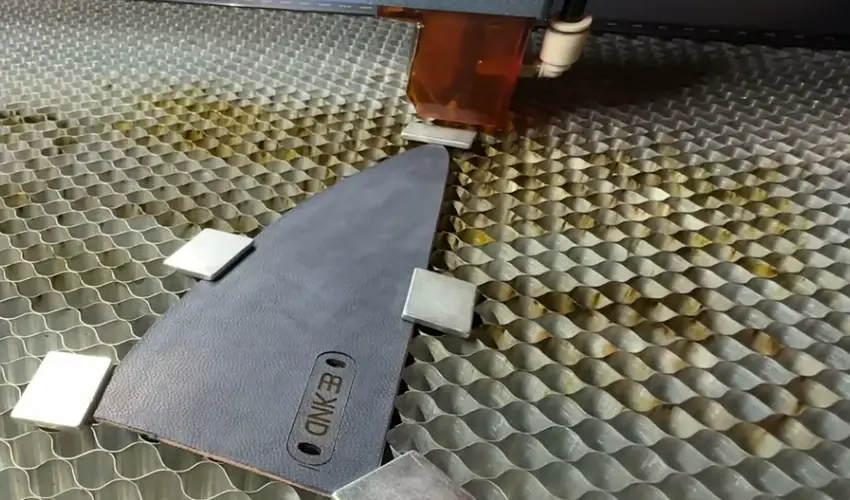
3. Understand Laser Settings:
- Balancing Act: Adjust laser power, speed, and resolution to strike the right balance. Lower power and higher speed settings often work well for preventing burning and achieving clean lines.
4. Focus on Proper Alignment:
- Precise Focusing: Ensure the laser is properly focused on the leather surface. Accurate focusing contributes to sharper and more defined engravings.
5. Consider Masking:
- Protective Masking: Use masking tape on the leather’s surface before engraving. This protects the material from smoke and residue, resulting in a cleaner finish. We have found this semi-transparent masking tape available on Amazon (Paid Link) to be the best.
6. Utilize Air Assist:
- Clear Debris: Employ air assist during engraving to blow away debris. This enhances visibility and prevents particles from settling on the engraved area.
7. Optimize for Detail:
- Higher Resolution: When engraving intricate designs, choose higher DPI settings for greater detail. This is particularly crucial for projects with fine lines or small text.
8. Keep Workspace Ventilated:
- Effective Ventilation: Ensure your workspace is well-ventilated to disperse smoke and fumes. Proper ventilation is vital for a healthier work environment.
9. Post-Processing Cleanup:
- Gentle Wiping: After engraving, gently wipe the leather with a soft, lint-free cloth to remove any residue or masking tape. This step contributes to a polished final appearance.
10. Explore Different Leather Types:
- Diversity in Material: Experiment with various types of leather, from full-grain to suede, to discover the unique qualities each brings to the engraving process.
11. Design with Engraving in Mind:
- Consider Engraving Space: When creating designs, consider the size and shape of the engraving area on the leather. This ensures that your designs fit seamlessly.
12. Maintain Your Equipment:
- Regular Maintenance: Keep your laser engraving equipment in optimal condition by following regular maintenance procedures. This includes cleaning lenses and checking for any loose components.
13. Patience and Practice:
- Skill Development: Mastering leather engraving takes time and practice. Be patient, embrace the learning process, and continually refine your techniques.
By incorporating these tips into your leather engraving endeavors, you’ll enhance the precision, quality, and overall success of your projects. Whether you’re a seasoned engraver or just starting, these guidelines will contribute to the mastery of this intricate and rewarding craft.
Conclusion
Choosing the right leather for laser engraving involves a thoughtful consideration of various factors, from leather type and thickness to texture and color. By understanding the characteristics of different leathers and experimenting with laser settings, enthusiasts and artisans can embark on leather engraving projects with confidence, creating unique and personalized items that showcase the beauty of this versatile material.

